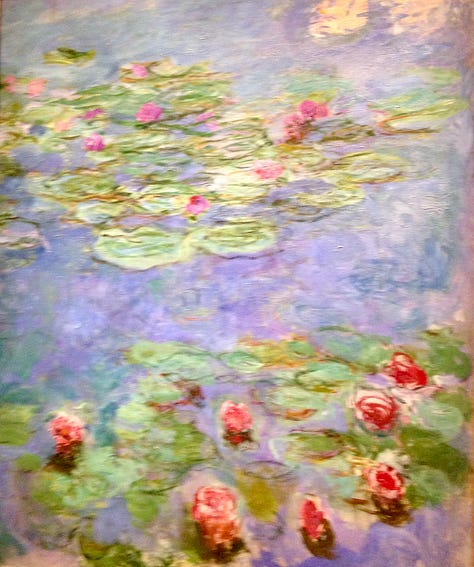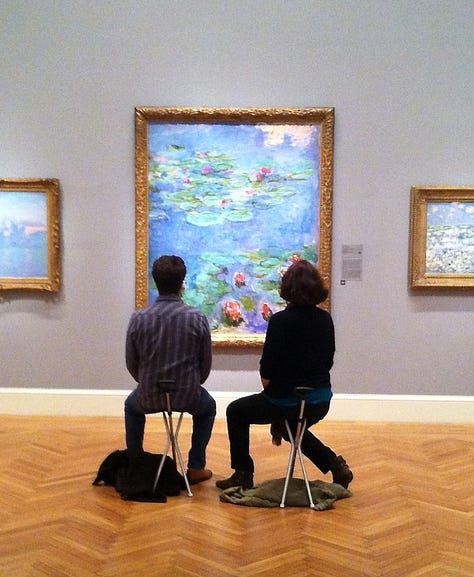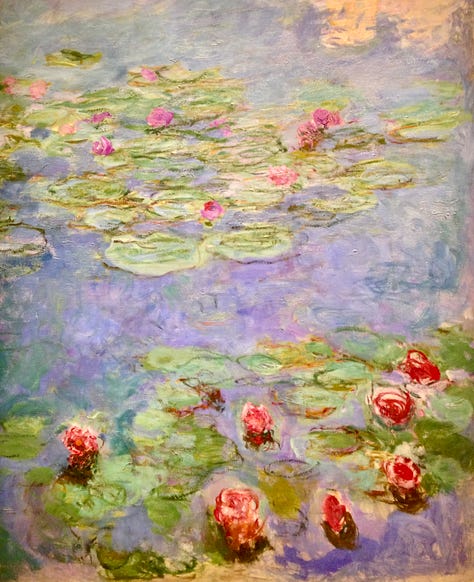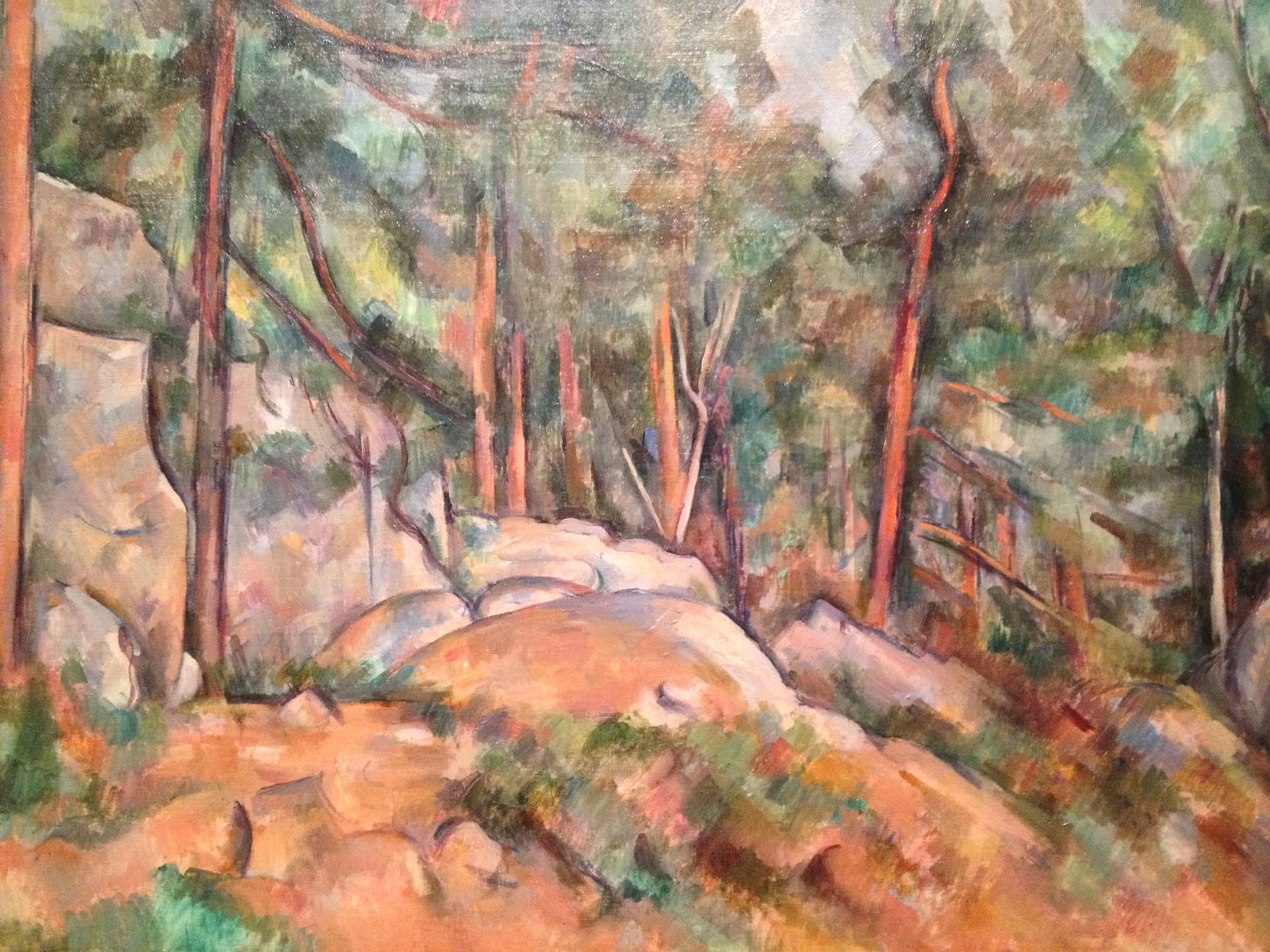Art in Transmission
If you’re overwhelmed by art (or bored, or mystified), try a new way of seeing



Cari amici,
When you live in a place as gut-wrenchingly beautiful as Italy, where art is as likely to be found on the street as in museums, it’s easy to become overwhelmed. We can’t be astonished every day, at every turn; it’s exhausting. Everywhere you go you’ll see religious images, painted or sculpted or made of mosaic, tucked into wall niches or tiny chapels; statues of man or myth, sculpted from stone or cast in bronze, in piazzas big and small; colorful frescoed ceilings glimpsed through windows; spectacular church facades in shades of marble more varied than you thought possible. In a worst-case scenario, with your senses overloaded, you can become immune to art and the emotions it generates.
If you don’t live here, you might think it could never happen to you. You come to Italy on vacation and wallow in all the artistic splendor, soak it up, marvel at it. As you should. As we all should. But if you find yourself here for any length of time, the day might come when you walk past, unseeing, what used to strike you dumb, glue you to the pavement. Or maybe you don’t particularly care for art; it’s not your thing (or so you think). Either way, it’s time for an intervention. It’s time to open yourself up and let art in.
I learned how to do this, and first wrote about the experience, during my MFA years at the University of San Francisco. Try it the next time you go to a museum, just for kicks. Sure, you’ll probably get a bit of side-eye from the people whizzing past you, rushing to “see” it all, but who cares?
Here’s what you do. Choose a museum—the Legion of Honor in San Francisco, let’s say. Sit yourself down in front of a painting—perhaps Claude Monet’s Water Lilies (ca. 1914-1917). Look at it for one hour—longer if you like, but not a minute less. Look at it until the swirling blues and purples teem with energy and life, until the fuschias and reds and salmony pinks, the greens that ride the spectrum from blue to yellow, seem to radiate joy. Look at it until a feeling of peace overtakes you and the open center of the water draws you in, until you can believe that with a clean dive you could pierce the canvas and breathe within that clear, endless water. If you do that, author Jeanette Winterson would say, you have engaged in the transmission of art, an idea she presents—and vehemently defends—in her essay collection Art Objects: Essays on Ecstasy and Effrontery.
I first read this book in 2012, for a terrific course called “Intention and Design in Prose,” created and taught by author/USF instructor/all-around brilliant guy Lewis Buzbee, and I’ve returned to it, and the first essay in particular (which gives the collection its name) over and over again. It’s not hyperbole to say that reading “Art Objects” changed the way I view art and, more important, the way I interact with it.
Winterson’s interest in fine art arose from her fascination with a painting she spotted in a shop window in Amsterdam—and her dismay when she realized she had no idea why it attracted her or what meaning it held. “I knew nothing about painting and so I got very little from it,” she writes in “Art Objects.” “I had never given a picture my full attention even for one hour.”
And so she did exactly that. Starting with one painting, then moving on to gallery after gallery, she sat with each selected artwork for one hour, trying to extract its meaning. She analyzed her own responses, both positive and negative—a cycle of discomfort, distraction, inventiveness, and irritation—recognizing them as part of a personal exchange between herself and the artist.
“If the true artist is connected, then he or she has much to give us because it is connection that we seek. Connection to the past, to one another, to the physical world, still compelling, in spite of the ravages of technology. A picture, a book, a piece of music, can remind me of feelings, thinkings, I did not even know I had forgot. Whether art tunnels deep under consciousness or whether it causes out of its own invention, reciprocal inventions that we then call memory, I do not know. I do know that the process of art is a series of jolts, or perhaps I mean volts, for art is an extraordinarily faithful transmitter. Our job is to keep our receiving equipment in good working order.”
The age of the artwork (and thus the circumstances and ideas that dominated the period of its creation) is immaterial to its effectiveness as a transmitter, Winterson says. The reason, she explained in a 2005 interview at raintaxi.com (no longer available online), is that the deeply rooted emotions and ideas that emerge from that transmission are not linked to a particular moment.
“When you look at a Caravaggio you don't think that you're in the 1600s in Rome; you go there because there's something compelling about that dark and light and that vision and strangeness that still moves us. That's why there are art galleries, that's why we still listen to classical music, why we still read books. It doesn't matter that they are not of the moment, it matters that they speak to something very deep in us which isn't of the moment either.”
But if the ideas and attitudes, conventions and mores that existed when the artist lived and created his work are unimportant in the process of transmission, the same can’t be said about the receptiveness of the reader, viewer, or listener. Personal preference plays an important role in that process. “For most of us,” Winterson writes in “Art Objects,” “the question ‘Do I like this?’ will always be the formative question. Vital then, that we widen the ‘I’ that we are as much as we can. Vital then, we recognize that the question ‘Do I like this?’ involves an independent object, as well as our own subjectivity.”
Part of that process of widening, she has made clear, is spending enough time with the art. We cannot expect a painting to speak to us if we glance at it “at a trot,” as Winterson says. Most of us give a novel, something that took the author years to create, perhaps ten or twelve hours of our time. We might listen to a favorite piece of music repeatedly, an accumulation of many hours over months or years. But how much of our time do we give to the paintings we see in a museum, each one of which took untold hours of its creator’s life? A minute? Maybe five, if we like it?
A classmate, Nate, and I were so taken by the ideas in “Art Objects” that we decided to imitate Winterson. Off we went to the Legion of Honor, where we laid some ground rules: we would choose a landscape or still life, anything without people in it, so that we wouldn’t distract ourselves from the work itself by creating a story where there was none. (We’re writers, after all; it happens.) We would look at the painting for one hour, without taking our eyes off it for even one second. That meant no peeking at cellphones, no glancing at other museum-goers, no talking to each other. We could move around, though, to study the painting up close, from a distance, from an angle. Afterward we would share our impressions, noting, in particular, any changes in our emotional response to the work.
We started with Paul Cézanne’s Forest Interior (ca. 1898-1899), chosen because we were emotionally neutral toward it. It didn’t take long for me to discover that a painting I’d thought of as innocuous and bland had become disturbing and dark, the yellows and reds and oppressive sky suggestive of fire, the rocks seeming to hold fast to half-buried faces. And so I distracted myself from that discomfort by analyzing the technique, by discovering a path through the woods, by finding refuge in the solitary patch of peaceful blue-gray at the painting’s center. Whether Cézanne saw in his painting what I did doesn’t matter. What matters is that in his brushstrokes, his choices, his intent, he said something to me, to you. And we respond with whatever it is that’s deep inside us—some timeless emotion that streaks out of us toward the painting’s surface and becomes immediate, recognizable, part of an exchange.
When the hour had ended, Nate and I stared at each other, blown away. There was so much more in that painting than we’d thought, and we’d seen similar things—the threat of fire in a patch of yellow, the imagined path (because is there one there, really?), the feeling of dread at the thought of walking down that path into the woods. Our initial apathy toward the painting mutated, creating an emotional bond between us and the painting. Immediately, we wanted to do it again. Another painting, another hour, this time with the aforementioned Water Lilies by Monet. Yes, that was my experience—real, not invented in writing to you. Among those rich pastels—too overtly pretty, I thought, to hold much depth—I found joy, peace, a sense of eternity.
Winterson, once ignorant about fine art, buys (or has bought) paintings. And they’ve changed her. “What has changed is my way of seeing,” she writes in “Art Objects.” “I am learning how to look at pictures. What has changed is my capacity of feeling. Art opens the heart.”
I’m curious to try this way of seeing with a painting I love and know well, one that’s rich in story and detail and whose meaning the experts still ponder. It’s time for another trip to the Uffizi, for an hour in the company of Botticelli’s Primavera. I’ve seen it four or five times, and I’ve lingered, but not for an hour. I can’t wait to find out what I’ve been missing.
A presto!
Cheryl
© 2023 Cheryl A. Ossola
Books of the week:
Art Objects: Essays in Ecstasy and Effrontery by Jeanette Winterson
The Yellow-Lighted Bookshop by Lewis Buzbee
Poems of the week (all ekphrastic, inspired by paintings):
“Cézanne’s Ports” by Allen Ginsberg
“Musée des Beaux Arts” by W.H. Auden
“Girl at Sewing Machine” by Mary Leader





I think I will practice this technique with my own small collection of beloved paintings here at home. Can't wait to discover what thoughts will "open my heart!"
Great essay, Cheryl. Some of what you mention reminds me of John Berger's "Ways of Seeing" series. Had to smile with your mention of the Legion of Honor. I have good memories from there. Of course you got your MFA in SF! I lived in the city 84-87, 89-90, and 1998-2000. :)